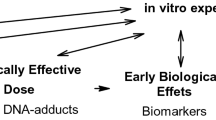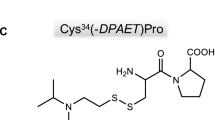Abstract
A high performance liquid chromatographic technique coupled with fluorometric detection was used to study the disappearance rate of the hemoglobin and albumin adducts of benzo(a)pyrene (BaP) in female Sprague-Dawley rats. The technique was considered adequate based on good recovery (>80%) of the analyte and satisfactory intra-assay coefficients of variations of 7.8% and 4.2% for hemoglobin and albumin adducts, respectively. The persistence of the adducts was determined in rats injected intravenously with 550 nmol BaP diolepoxide, the electrophilic metabolite of BaP. In a first experiment the isolated protein fractions were directly subjected to mild acid hydrolysis to yield the ultimate analyte, BaP tetrol. In a second experiment these fractions were first digested by proteases in order to liberate any unbound lipophilic BaP tetrol possibly “hidden” in the hydrophobic portions of the protein matrices. It was found that 70–100% of the measured tetrols originated from true adducts. The half-life of the free tetrol was 2.8 and 1.6 days in the hemoglobin and albumin fractions, respectively, compared to 10.7 and 3.6 days for the true adducts. Based on the total amount of tetrols, the mean half-life of the latter in the hemoglobin and albumin fractions determined from the two experiments was 9.0 and 2.7 days, respectively, assuming first order kinetics. The greater persistence of the hemoglobin adduct compared to that of the albumin adduct is coherent with the biological half-life of the intact proteins. However, the observed disappearance profile obtained does not fit with current models of adduct formation and removal.
Similar content being viewed by others
References
Bechtold WE, Sun JD, Wolff RK, Griffith WC, Kilmer JW, Bond JA (1990) Globin adducts of benzo(a)pyrene: markers of inhalation exposure as measured in F344/N rats. Toxicology 11: 115–118
Bechtold WE, Willis JK, Sun JD, Griffith WC, Reddy TV (1992) Biological markers of exposure to benzene — S-phenylcysteine in albumin. Carcinogenesis 13: 1217–1220
Birner G, Albrecht W, Neumann H-G (1990) Biomonitoring of aromatic amines III: Hemoglobin binding of benzidine and some benzidine congeners. Arch Toxicol 64: 97–102
Bjelogrlic N, Vahakangas K (1991) Benzo[a]pyrene-globin adducts detected by synchronous fluorescence spectrophotometry: method development and relation to lung DNA adducts in mice. Carcinogenesis 12: 2205–2209
Cheever KL, DeBord DG, Swearengin TF, Booth-Jones AD (1992) ortho-Toluidine blood protein adducts: HPLC analysis with fluorescence detection after a single dose in the adult male rat. Fundam Appl Toxicol 18: 522–531
Chen TH, Braselton WE Jr (1991) Unlabeled hemoglobin adducts of 4,4′-methylenebis (2-chloroaniline) in rats and guinea pigs. Arch Toxicol 65: 177–185
DeBord DG, Swearengin TF, Cheever KL, Boothjones AD, Wissinger LA (1992) Binding characteristics of ortho-toluidine to rat hemoglobin and albumin. Arch Toxicol 66: 231–236
Fennell TR (1990) Biological markers of exposure to chemical carcinogens. In: CIIT activities: Chemical Industry Institute of Toxicology, 10 No. 1, pp 1–7
Fennell TR, Sumner SCJ, Walker VE (1992) A model for the formation and removal of hemoglobin adducts. Cancer Epidemiol Biomarkers Prev 1: 213–220
Jain NC (1986) Schalm's veterinary hematology. Lea & Febiger, Philadelphia, PA
Lee BM, Santella RM (1988) Quantitation of protein adducts as a marker of genotoxic exposure: immunologic detection of benzo(a)pyreneglobin adducts in mice. Carcinogenesis 9: 1773–1777
Nordqvist MB, Lof A, Osterman-Golkar S, Walles SAS (1985) Covalent binding of styrene and styrene-7,8-oxide to plasma proteins, hemoglobin and DNA in the mouse. Chem Biol Interact 55: 63–73
Okoye ZSC, Riley J, Judah DJ, Neal GE (1990) The in vivo site of formation of a carcinogen-serum albumin adduct. Biochem Pharmacol 40: 2560–2562
Osterman-Golkar S, Kautiainen A, Bergmark E, Hakansson K, Maki-Paakkanen J (1991) Hemoglobin adducts and urinary mercapturic acids in rats as biological indicators of butadiene exposure. Chem Biol Interact 80: 291–302
Pereira MA, Lin L-HC, Chang LW (1981) Dose dependency of 2-acetylaminofluorene binding to liver DNA and hemoglobin in mice and rats. Toxicol Appl Pharmacol 60: 472–478
Rahn R, Chang S, Holland J, Shugart L (1982) A fluorometric-HPLC assay for quantitating the binding of BaP metabolites to DNA. Biochem Biophys Res Commun 109: 262–268
Santella RM, Zhang YJ, Young TL, Lee BM, Lu XQ (1990) Monitoring human exposure to environmental carcinogens. Adv Exp Med Biol 283: 165–181
Shugart L (1985) Quantitating exposure to chemical carcinogens: in vivo alkylation of hemoglobin by benzo[a]pyrene. Toxicology 34: 211–220
Shugart L, Kao J (1985) Examination of adduct formation in vivo in the mouse between benzo(a)pyrene and DNA of skin and hemoglobin of red blood cells. Environ Health Perspect 62: 223–226
Sipes IG, Gandolfi AJ (1991) Biotransformation of toxicants. In: Amdur MO, Doull J, Klaassen CD (eds) Casarett and Doull's toxicology. Pergamon Press, New York, pp 88–126
Sun JD, Dahl AR, Bond JA, Birnbaum LS, Henderson RF (1989) Characterization of hemoglobin adduct formation in mice and rats after administration of [14C]butadiene or [14C]isoprene. Toxicol Appl Pharmacol 100: 86–95
van Welie RTH, van Dijck RGJM, Vermeulen NPE, Vansittert NJ (1992) Mercapturic acids, protein adducts, and DNA adducts as biomarkers of electrophilic chemicals. Crit Rev Toxicol 22: 271–306
Author information
Authors and Affiliations
Rights and permissions
About this article
Cite this article
Viau, C., Mercier, M. & Blondin, O. Measurement of hemoglobin and albumin adducts of benzo(a)pyrenediolepoxide and their rate of elimination in the female Sprague-Dawley rat. Arch Toxicol 67, 468–472 (1993). https://doi.org/10.1007/BF01969917
Received:
Accepted:
Issue Date:
DOI: https://doi.org/10.1007/BF01969917




